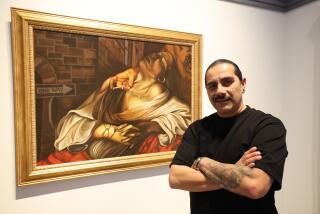Viredo Espinosa dies; Cuban Abstract Expressionist painter was 83
Viredo Espinosa, a member of a revolutionary group of artists in 1950s Cuba whose Abstract Expressionism expanded the scope of the country’s modern art, died Sunday in Costa Mesa. He was 83.
Espinosa, who fled Cuba in 1969 and eventually settled in Southern California, died of natural causes at a nursing facility, said his friend Mariano Sanchez.
The Cuban artists were called the Group of the Eleven and introduced non-figurative, abstract works into modern art in their home country, said Raul Fernandez, who is chairman of UC Irvine’s department of Chicano Latino Studies and curated a traveling Smithsonian exhibition on Latin jazz art that featured several Espinosa works. The exhibit came to Los Angeles in 2005.
When the community of artists came under scrutiny in Cuba for anti-government sentiments, many — including Espinosa — went in to self-exile. The artist and his wife spent time in Miami before coming to Los Angeles, where he found work as a commercial artist for department stores.
He also painted murals, including a sprawling outdoor scene inside a now-closed Queen City Bank building in Long Beach.
By 1977, he was financially able to pursue his fine-art career full-time.
He was “a very high-quality artist,” local Cuban art expert Adolfo Nodal told the Orange County Register in 2008, but suffered “from what many Cuban refugee artists suffer from. He left Cuba, was against the government, sort of got blacklisted by the Cuban government, and wiped out of the history of Cuban art.”
Espinosa’s paintings and linocuts were greatly influenced by his Afro-Cuban upbringing in his native Regla, a small town across the bay from Havana. He was born Oct. 14, 1928, and studied art as an adolescent at several Havana schools.
He grew up around “so much folklore that it was a direct influence, and I am still working from that place,” Espinosa told the Miami Herald in 2003.
Before he moved into Abstract Expressionism, his early technique was influenced by childhood drawings, he once said, but his later “more reflective style” combined elements of both.
Between 1970 and 2009, his art was featured in dozens of exhibitions, mainly in Southern California. His final solo show was in 2010 at the Old Towne Gallery in Tustin.
In 1998, KCET honored Espinosa for contributions to the Cuban community that included designing posters for the Cuban-American Scholarship Fund.
Since 1976, he had lived in the Irvine-Costa Mesa area. Espinosa moved there to be near the water, which he said reminded him of his youth.
His survivors include Alicia, his wife of 57 years, and a sister, Noigma.
Services will be held at 10 a.m. Saturday at St. Joachim Catholic Church, 1964 Orange Ave., Costa Mesa.
More to Read
Start your day right
Sign up for Essential California for the L.A. Times biggest news, features and recommendations in your inbox six days a week.
You may occasionally receive promotional content from the Los Angeles Times.







